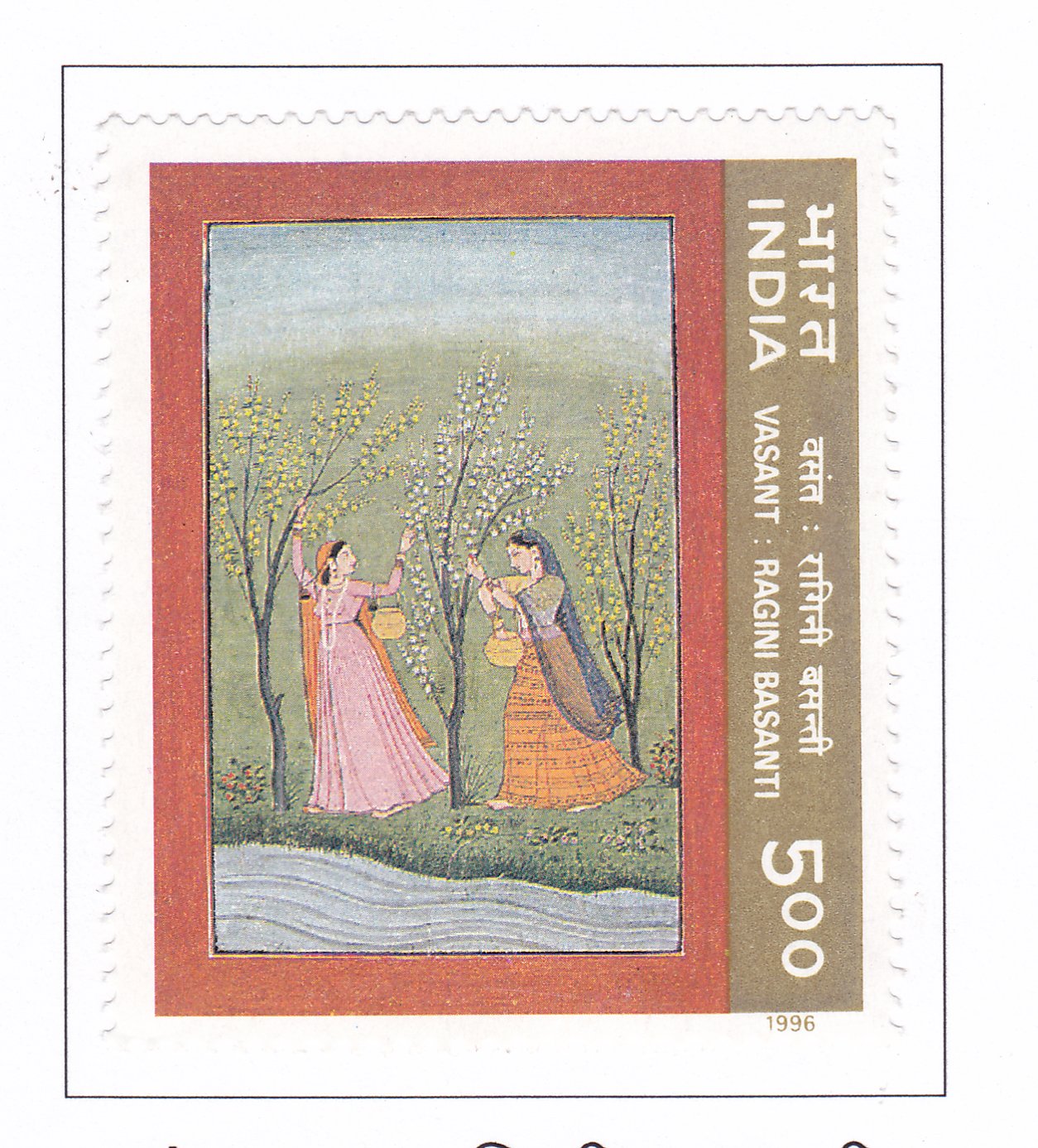Ritu Rang – “Vasant” (Spring) (Ragini Basanti)

Technical Data
| Stamp Set | Paintings of the Seasons |
|---|---|
| Date of Issue | March 13, 1996 |
| Denomination | Rs. 5 |
| Quantity | 1,000,000 |
| Perforation | comb 13½ |
| Printer | Security Printing Press, Nashik |
| Watermark | No Watermark |
| Colors | Multicolor |
| Catalog Codes |
Michel IN 1491 Stamp Number IN 1556 Yvert et Tellier IN 1301B Stanley Gibbons IN 1658 |
| Themes | Art | Paintings | Seasons |
Table of Contents
Ritu Rang – Vasant
India’s rich cultural heritage is beautifully reflected in its art forms, and among them, the delicate art of Indian Miniature Painting stands out as a vivid tapestry of history, poetry, and nature. This form of art, which originated with the Mughals, evolved into a unique expression of Indo-Saracenic genius, blending influences from various regions and eras to create masterpieces that captured the essence of the Indian ethos.
The Origin and Evolution of Indian Miniature Painting
Indian Miniature Painting began as a form of artistic expression in the Mughal courts, depicting scenes of imperial grandeur, battles, and court life. Over time, these miniatures expanded beyond the confines of the Mughal Empire, embracing themes from the rich cultural landscape of India. As the art form spread from Kangra to Rajasthan and the Deccan, it gave rise to various sub-schools, each with its own distinctive style and interpretation.
Poetic Inspiration and Artistic Expression
One of the most enchanting aspects of Indian Miniature Painting is its ability to merge poetry with visual art. The romantic and mystical verses of poets like Jayadeva, who wrote the “Gita Govinda,” and Keshav Das, with his “Kavipriya” and “Rasikpriya,” found expression in these exquisite miniatures. The paintings brought to life the emotions, colors, and moods described in the verses, creating a harmony that resonated with the viewers.
The Depiction of Seasons in Indian Miniature Painting
A notable feature of Indian Miniature Painting is its portrayal of the six seasons of India: Vasant (Spring), Greeshm (Summer), Varsha (Monsoon), Sharad (Autumn), Hemant (Winter), and Shishir (Late Winter). This tradition of celebrating the seasons in art and literature dates back to Kalidasa’s “Ritusamhara,” where each season is described in the language of romantic love. Subsequent writers and artists continued this tradition, extolling the beauties of each month and season.
Ritu Rang, a tribute by India Post to this rich tradition, features four miniature paintings that capture the essence of four seasons: Vasant, Greeshm, Varsha, and Hemant.
- Vasant (Spring): This season of renewal and bloom is depicted through a painting inspired by Rag Basanti, a musical mode that embodies the spirit of spring. The painting is vibrant, reflecting the flowering beauty and freshness of the season.
- Greeshm (Summer): The scorching heat of the summer is portrayed through the struggles of a warrior deterred from his campaign, emphasizing the intense heat and sweltering conditions typical of this season.
- Varsha (Monsoon): Celebrated in Rag Megh Malhar, the season of monsoon is depicted with life-giving rain, dark clouds, and the joy of kings and commoners alike. The painting captures the relief and rejuvenation that the rains bring to the land.
- Hemant (Winter): The heart of winter is illustrated through the warmth of a fire, the snug comfort of quilts, and the biting cold outside. The painting encapsulates the coziness and stillness of the winter months.
Conclusion
The “Ritu Rang” stamp set by India Post is a fitting homage to the art of Indian Miniature Painting, capturing the intricate details and profound emotions associated with each season. Through these stamps, the timeless blend of poetry, nature, and art continues to enchant and inspire, preserving India’s artistic legacy for generations to come.
